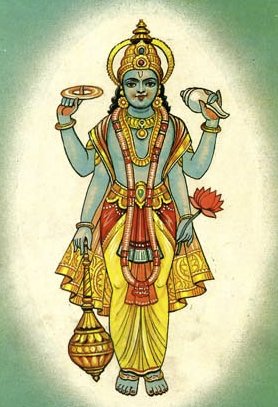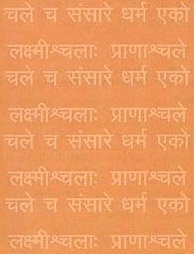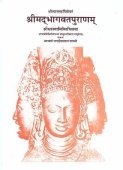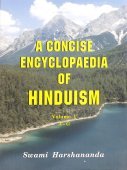Jnanayoga, Jñānayoga, Jnana-yoga, Jnana-Yoga: 12 definitions
Introduction:
Jnanayoga means something in Hinduism, Sanskrit. If you want to know the exact meaning, history, etymology or English translation of this term then check out the descriptions on this page. Add your comment or reference to a book if you want to contribute to this summary article.
In Hinduism
Vaishnavism (Vaishava dharma)
Source: ISKCON Press: GlossaryJñānayoga (ज्ञानयोग).—The process of approaching the Supreme by the cultivation of knowledge; the predominantly empirical process of linking with the Supreme, which is executed when one is still attached to mental speculation.
Source: Pure Bhakti: Bhagavad-gita (4th edition)Jñānayoga (ज्ञानयोग) refers to “path of spiritual realization through a philosophical search for truth”. (cf. Glossary page from Śrīmad-Bhagavad-Gītā).

Vaishnava (वैष्णव, vaiṣṇava) or vaishnavism (vaiṣṇavism) represents a tradition of Hinduism worshipping Vishnu as the supreme Lord. Similar to the Shaktism and Shaivism traditions, Vaishnavism also developed as an individual movement, famous for its exposition of the dashavatara (‘ten avatars of Vishnu’).
Purana and Itihasa (epic history)
Source: Cologne Digital Sanskrit Dictionaries: The Purana IndexJñānayoga (ज्ञानयोग).—For the ascetic and the detached. A true jñāni forgets himself;1 resultant of Karma Yoga.2

The Purana (पुराण, purāṇas) refers to Sanskrit literature preserving ancient India’s vast cultural history, including historical legends, religious ceremonies, various arts and sciences. The eighteen mahapuranas total over 400,000 shlokas (metrical couplets) and date to at least several centuries BCE.
Vedanta (school of philosophy)
Source: Shodhganga: Siva Gita A Critical StudyJñānayoga (ज्ञानयोग) refers to “union of knowledge”.—The esoteric spiritual practices of the fully enlightened being, or jñāni. An alternative meaning popularized by Svāmi Vivekānanda, is the quest for cognition through intellectual religious study, as one of four alternate paths to truth, the other tree being bhakti-yoga, karma-yoga and rāja-yoga.

Vedanta (वेदान्त, vedānta) refers to a school of orthodox Hindu philosophy (astika), drawing its subject-matter from the Upanishads. There are a number of sub-schools of Vedanta, however all of them expound on the basic teaching of the ultimate reality (brahman) and liberation (moksha) of the individual soul (atman).
Shaivism (Shaiva philosophy)
Source: Brill: Śaivism and the Tantric TraditionsJñānayoga (ज्ञानयोग) refers to “(the practices of) jñāna and yoga”, according to the Jayadrathayāmala, Ṣaṭka 1 verse 13.3–18::—Accordingly, “And that [initiation] is either a Samayadīkṣā or Nirvāṇādīkṣā, divided into two because it has two natures. Now the Samayadīkṣā is further twofold because of a difference in the result. [The first] bestows adhikāra [and] follows the practices of jñāna and yoga [i.e., jñānayoga-pravṛtti], [the second] destroys the latent impressions (vāsana) of that [soul?] and bestows a state of eternal pervasion [with the deity]. [That is known] by the firm ones who know the Tantras. [...]

Shaiva (शैव, śaiva) or Shaivism (śaivism) represents a tradition of Hinduism worshiping Shiva as the supreme being. Closely related to Shaktism, Shaiva literature includes a range of scriptures, including Tantras, while the root of this tradition may be traced back to the ancient Vedas.
Shaktism (Shakta philosophy)
Source: Google Books: ManthanabhairavatantramJñānayoga (ज्ञानयोग) refers to the “Yoga of Knowledge”, according to verse 11.39-45 of the Kularatnoddyota, one of the earliest Kubjikā Tantras.—Accordingly, “O beloved, there will be a great Siddha in (the fish’s) belly born of the vitality of the Command and he will, O Mahāmāyā, practice the (teaching of) that scripture by himself. That scripture was thrown into the sea by (the goddess’s) son by means of the Yoga of Knowledge (jñānayoga). [...]”.

Shakta (शाक्त, śākta) or Shaktism (śāktism) represents a tradition of Hinduism where the Goddess (Devi) is revered and worshipped. Shakta literature includes a range of scriptures, including various Agamas and Tantras, although its roots may be traced back to the Vedas.
Languages of India and abroad
Sanskrit dictionary
Source: DDSA: The practical Sanskrit-English dictionaryJñānayoga (ज्ञानयोग).—contemplation as the principal means of, attaining the Supreme spirit or acquiring true or spiritual knowledge; ज्ञानयोगेन सांख्यानां कर्मयोगेण योगिनाम् (jñānayogena sāṃkhyānāṃ karmayogeṇa yoginām) Bhagavadgītā (Bombay) 3.3.
Derivable forms: jñānayogaḥ (ज्ञानयोगः).
Jñānayoga is a Sanskrit compound consisting of the terms jñāna and yoga (योग).
Source: Cologne Digital Sanskrit Dictionaries: Cappeller Sanskrit-English DictionaryJñānayoga (ज्ञानयोग).—[masculine] the practice of knowledge.
Source: Cologne Digital Sanskrit Dictionaries: Monier-Williams Sanskrit-English DictionaryJñānayoga (ज्ञानयोग):—[=jñāna-yoga] [from jñāna > jñā] m. the Yoga as based on the acquisition of true knowledge (opposed to karma-y or the Yoga as based on performance of ceremonial rites), [Bhagavad-gītā iii, 3; Viṣṇu-purāṇa vi, 4, 42; Nāradīya-purāṇa; Matsya-purāṇa]
[Sanskrit to German]
Sanskrit, also spelled संस्कृतम् (saṃskṛtam), is an ancient language of India commonly seen as the grandmother of the Indo-European language family (even English!). Closely allied with Prakrit and Pali, Sanskrit is more exhaustive in both grammar and terms and has the most extensive collection of literature in the world, greatly surpassing its sister-languages Greek and Latin.
Kannada-English dictionary
Source: Alar: Kannada-English corpusJñānayōga (ಜ್ಞಾನಯೋಗ):—[noun] contemplation as a means of attaining the Supreme knowledge.
Kannada is a Dravidian language (as opposed to the Indo-European language family) mainly spoken in the southwestern region of India.
See also (Relevant definitions)
Starts with: Jnanayogakhanda.
Ends with: Ajnanayoga, Vijnanayoga.
Full-text: Neti-neti, Jnana Yoga, Yoga, Jnanayogakhanda, Jnana, Pranayamavidhi, Shikhidhvaja, Nairgunya, Vyavasthiti, Mahatantra, Atmashakti, Karmayoga, Bhagavad-gita, Khandikya, Kapila.
Relevant text
Search found 51 books and stories containing Jnanayoga, Jnana-yoga, Jnana-yoga, Jñāna-yoga, Jñāna-yōga, Jñānayoga, Jñānayōga; (plurals include: Jnanayogas, yogas, yōgas, Jñānayogas, Jñānayōgas). You can also click to the full overview containing English textual excerpts. Below are direct links for the most relevant articles:
Social philosophy of Swami Vivekananda (by Baruah Debajit)
Chapter 3.5 - Ways to God (Karma, Bhakti, Raja and Jnana Yoga)
Chapter 1.0 - Introduction (Swami Vivekananda’s life and history)
Sivaprakasam (Study in Bondage and Liberation) (by N. Veerappan)
Means of release in Vishishtadvaita < [Chapter 6 - Means to Release]
Carya, Kriya,Yoga and Jnana < [Chapter 6 - Means to Release]
Divine Help of Pancaksara < [Chapter 6 - Means to Release]
Yoga Vasistha [English], Volume 1-4 (by Vihari-Lala Mitra)
Chapter II - Sciences connected with yoga < [The yoga philosophy]
Chapter IX - Origin of yoga in the vedas < [The yoga philosophy]
Chapter X - Rise of the heretical yogas < [The yoga philosophy]
Romanticism and Classicism in Hindu Mythology < [April – June, 2003]
The Theme of Deliverance < [January - March 1972]
Yoga and Scientific Thought < [April 1959]
The Matsya Purana (critical study) (by Kushal Kalita)
Part 5 - Yoga philosophy in the Matsyapurāṇa < [Chapter 5 - Philosophy in the Matsyapurāṇa]
Part 4 - Contents of the Matsyapurāṇa (summary) < [Chapter 1 - Introduction]
Consciousness in Gaudapada’s Mandukya-karika (by V. Sujata Raju)
The Yoga of non-contact (Asparśa-Yoga) < [Chapter 5: A Study of Māṇḍūkya Kārikā: Advaita Prakaraṇa]
Related products

